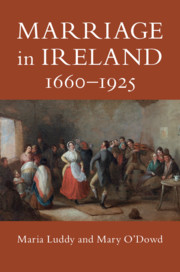Book contents
- Marriage in Ireland, 1660–1925
- Marriage in Ireland, 1660–1925
- Copyright page
- Dedication
- Contents
- Figures
- Illustrations
- Tables
- Acknowledgements
- Abbreviations
- Introduction
- Part I What Is a Marriage?
- Part II Ways to Marriage
- Part III Happy Ever After?
- 7 Marital Relations
- 8 Adultery and Sex outside Marriage
- 9 Bigamy
- Part IV The Unmaking of Marriage
- Conclusion
- Select Bibliography
- Index
8 - Adultery and Sex outside Marriage
from Part III - Happy Ever After?
Published online by Cambridge University Press: 04 June 2020
- Marriage in Ireland, 1660–1925
- Marriage in Ireland, 1660–1925
- Copyright page
- Dedication
- Contents
- Figures
- Illustrations
- Tables
- Acknowledgements
- Abbreviations
- Introduction
- Part I What Is a Marriage?
- Part II Ways to Marriage
- Part III Happy Ever After?
- 7 Marital Relations
- 8 Adultery and Sex outside Marriage
- 9 Bigamy
- Part IV The Unmaking of Marriage
- Conclusion
- Select Bibliography
- Index
Summary
Marital infidelity was not uncommon in the period covered in this book. Nor was it, for much of the time, a hidden or concealed crime. Newspapers regularly reported on bigamy, criminal conversation, divorce and desertion cases that came before the Irish courts and often involved adulterous behaviour. It is impossible to know how extensive extra-marital sexual behaviour was in any period. In this chapter we explore the attitudes expressed towards adulterous behaviour and couples who cohabited without marrying, how such behaviour reflected upon marital relationships and what it says more generally about sexuality in Irish society.Printed reports and newspaper accounts of trials for criminal conversation were an important medium through which the public became aware of adulterous affairs.This chapter reveals the level of non-conformity that existed in sexual matters amongst individuals and couples over a long time period.Sexual non-conformity can be viewed for instance, in cohabitation, adultery, the keeping of mistresses, and the advantage taken of women servants in households. By the end of the nineteenth century, both the Church and the law increasingly oversaw the implementation of sexual norms in society and perpetuated ideals for male and female sexual behaviour.
Keywords
- Type
- Chapter
- Information
- Marriage in Ireland, 1660–1925 , pp. 260 - 282Publisher: Cambridge University PressPrint publication year: 2020

